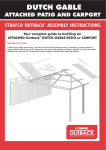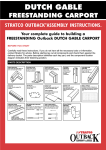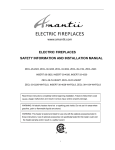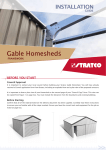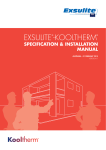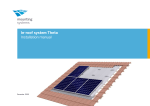Download Installation
Transcript
INSTALLATION GUIDE Solatop TM PV INTEGRATED ROOF SYSTEM BEFORE YOU START Carefully read these instructions. If you do not have all the necessary tools or information, contact Stratco for advice. Before starting lay out all components and check them against the delivery docket. TOOLS REQUIRED • • • • • Drill & Hex Adaptor Allen Keys Spanner Set Large Square Markout Pen • • • • • String Line Tape Measure Tin Snips Gloves Ladder • • • • Hammer Side Cutters Wire Strippers MC4 & MC3 Crimping • Silicone Gun • Screw Driver • Masonary Drills GENERAL SAFETY INFORMATION Installers are to take suitable precautions when working on roof tops and should abide by all local regulations. The installation guide does not document all responsibilities or requirements of the installer/electrician. It is the installer’s responsibility to follow all local OH&S, electrical codes and regulations. The installer assumes the risk of all injury that might occur during installation. COMPONENT LAYOUT 2 3 1 4 7 11 1 - Mount Batten 8 2 - Solatop™ PV Panel 9 3 - Outer Gutter Tray 6 4 - Inner Gutter Tray 5 - Bottom Mount Bracket 6 - Top Mount Bracket 10 13 7 - Sarking Membrane 8 - SHCS M6x16 S/S 5 9 - 6mm Spring Washer S/S 10 - 12x20 Self Drilling Screw 11 - Existing Roof Rafter 12 - Panel Support Bracket Type 1 12 13 - Panel Support Bracket Type 2 ELECTRICAL SAFETY INFORMATION All wiring and circuit connections are to be performed by a suitably qualified electrician following sound electrical practice for AC and DC circuits. Contact with electrically active parts of the panels and system, such as terminals can result in sparks, injury, fire burns and lethal shock whether the module is connected or disconnected. Short circuits in a DC circuit can cause electrical arching, which can seriously burn and is a fire hazard. Do not cut any DC wires or stick conductive objects in to connectors or junctions. Disconnecting circuits or components of a DC circuit, while under load or when generating power, can cause arching which may not be self extinguishing. Before disconnecting connectors, place a blanket over the panels to eliminate exposure to sunlight, to stop the DC current flow. Do not use damaged modules. Check each module for damage to the back sheet of the Solatop PV panels and discard any module with scratches or cuts. Damaging a back sheet can cause a fire risk and will void the panel’s warranty. Isolation boxes are required to be installed as close to the panel array/strings as possible and in an accessible position if the array/strings have to be disconnected from the inverter in an emergency. Refer all local regulations and electrical codes when evaluating a suitable location. The Solatop PV panel is supplied with pre-wired MC4 connectors. Do not terminate or cut these connectors during installation. Only use pre-wired extension leads with MC4 connectors installed. Contact Stratco for the supply of a range of lengths, for connection leads and multi-way junction connectors. Make sure all Solatop PV panels are disconnected when wiring the isolation boxes and isolation box string connection leads. Solatop PV panels have been designed for residential applications. Do not use mirrors, magnification equipment or other means to artificially concentrate sunlight onto the Solatop PV panels. Make sure the work site is dry and clean before and during the installation. Do not apply adhesives or paint to the underside or top of the Solatop PV panels. Never attempt to disassemble the Solatop PV panels or remove the serial number plate on the underside of panel. Lift and carry the Solatop PV panels from the edge of the glass only. Do not attempt to lift or carry while holding the junction box or by the wiring. IMPORTANT The installation is to conform to the following Australian Standards; AS/NZS 5033:2005 - Installation of Photovoltaic (PV) Arrays AS/NZS 3000:2007 - Electrical Installations AS/NZS 4777:2005 - Grid Connection of Energy Systems via Inverters 1.0 INTRODUCTION The installation guide is intended for experienced solar installers or individuals who have been suitably trained and qualified. Photovoltaic installations must only be connected to the public electricity grid by licensed electricians. Note: The electrical voltages at solar installations connected to the grid are usually life-threatening, and improper installation can also result in fire. levels and bolting locations before cutting, screwing or bolting structural members. It is recommended that the persons erecting the structure have had some previous building experience because some modifications to the existing house structure are required. Stratco disclaims all liability for damages caused by inadequate planning or faulty installation. Please read these assembly instructions thoroughly before commencing the construction. Double check all dimensions, 1.1 DIMENSIONS 33 6 943 172 970 3 1100 33 25 3 25 1.2 SPECIFICATION The Solatop PV panels consist of silicon solar sells, clear glass, EVA (ethyl vinyl acetate), a highly durable plastic rear film (tedlar composite), tin-plated copper soldering ribbons, semiconductor bypass diodes, connecting cables and connectors). SOLATOP™ PV PANEL ELECTRICAL SPECIFICATIONS MODEL Numer of Cells Size of Cells Solatop PV panels are supplied with prewired flying leads with MC4 connectors, for series connection of multiple Solatop PV panels. The Gutter Trays, Roof Battens and Panel Support Brackets consist of Zinc/AL coated mild steel. The Panel Mount Brackets are made from plastic coated aluminium. Cell Type Panel Construction Nominal Mass Overall Size Wp STBPM165105 42 in Series 125mm x 125mm Mono - Si Glass/EVA/Cells/EVA/Backsheet 14kg 943mmx970mm x35mm 105W All electrical specifications are at standard test conditions (AM1.5, 1000±50W/m2, 24±oC). The current output of the module shown in the Electrical Specifications Table is measured at Standard Test Conditions and all electrical specifications will have a variation tolerance of ±5%. These conditions may not be frequently observed in actual practice. Vmp 21.26V Voc 26.49V Impp 4.94A Isc 5.29A System Vmax 1000V Under normal conditions, a photovoltaic module is likely to experience conditions that produce more current and/or voltage than reported at standard test conditions. Accordingly, the values of Short-Circuit Current and Open-Circuit Voltage marked on the module should be multiplied by a factor of 1.25 when determining component voltage ratings, conductor current ratings, fuse sizes, and size of controls connected to the PV output. Open-Circuit Voltage (%/deg C) & (mV/deg C) IMPORTANT Maximum Series Connections = System Vmax / Voc Maximum Parallel Connections = Over Current (A) / (Isc×1.25) Connection Cable Temperature Rating Bypass Diode Rating Junction Box Max Rated Current Junction Box IP Rating Connection Cable Type Connection Cable Maximum Voltage -0.33% / k 12A Over Current Protection 10A 65 PV1-F1x4.0mm2 -40 to + 85ºC 1000V Fire Rating C Application Class A 1.3 HANDLING AND TRANSPORT All components should be handled with care. The Solatop PV panels are particularly breakable. The electronic equipment (junction boxes, power inverters, sensors etc) should be stored in a dry place. During transport, unloading, intermediate storage and installation they must be handled with great care. The electrical connectors on the modules need to be protected against contact with water (rain, snow etc). The Gutter Tray’s need to be protected against physical damage and excessive bending during the handling of long sections should be avoided due to the risk of breakage and injury. 1.4 ELECTRICAL CONNECTIONS, CABLE TYPES Each Solatop PV panel has flying leads pre-wired to the connection box, with MC4 connectors wired to each end of the lead. Shielded cable with an adequate cross-section, intended for use with solar installations is recommended for connection of the marshalling, isolation and power inverters. Array connections to the marshalling box or junction connectors are to be made with original MC4 leads and junction connectors. Do not cut the flying leads, under any circumstance. The connectors between the modules are to be MC4 connectors. 1.5 EDGE CONTACTS AND CONNECTIONS Edge connections should usually be dealt with by a tinsmith or roofer. This covers the flashings, ridge covering, eaves, insect shields, inflow sheets, skylight edges, chimneys, dormers etc. Junctions with normal roofing materials require prior inspection and planning, and should be carried out under the auspices of an expert who is authorised to carry out the related operations. Materials for these edges (for example titanium zinc, copper, galvanised tin etc) should be selected in accordance with materials used on the roof. IMPORTANT The Gutter Tray’s are only large enough to cope with water that runs over the edge of the modules. They should not be used as “collective” water channels under any circumstances. It is also of absolute importance that the collected water is never channelled directly into the Gutter Tray’s but onto the middle of the module (small amounts) or even better into other channels appropriate to the task. 2.0 INTEGRATION INTO AN EXISTING ROOF & WIND LOAD CAPABILITIES The builder or council is to ensure the existing house/structure is of a suitable structural integrity and complies with all the relevant Australian Building codes and standards. Materials for these edges (for example titanium zinc, copper, galvanised tin etc) should be selected in accordance with materials used on the roof. Roof structure suitability is based on the Solatop PV panels, Panel Mount Brackets, Mounting Batten, Panel Support Bracket and Gutter Tray’s having a combined mass of 25kg per 1m2. The Solatop PV panel system has been engineered for residential applications in accordance with AS4055-2006 Wind loads for housing. The system can withstand loads from wind class, up to and including, N4 and a maximum wind speed of 50m/s (permissible). Refer to your local authorities for wind classification in the specific installation site area. The roof rafters are to have a maximum spacing of 1200mm and to be in sound condition to withstand the systems mass and environmental loading. Due to fire hazards, a fire resistant barrier will be required to be installed between the Mounting Battens and Rafters. Fire resistant barriers, similar to sarking membranes and sealing tapes, have to comply with local requirements and building codes for fire resistance and stability. For more information regarding the suitability of the house structure to accommodate the Solatop PV panel system, consult a structural engineer or a building authority. It is the builder’s responsibility to ensure that the existing house roof structure is capable of withstanding additional loads imposed by the Solatop PV system. 2.1 POTENTIAL APPLICATIONS In principle, Solatop PV panels can be installed on any roof with a minimum slope of 20º and facing the equator. It can occupy entire roof surfaces or just a portion of the roof surface, meaning that there are an almost unlimited number of potential configurations. Roofs with a slope of less than 20° should be assessed individually. As far as possible, roofs should not lie in the shadow of trees, neighbouring buildings or other objects on the roof itself, otherwise performance will be correspondingly reduced. It may be necessary to plan for the use of dummy elements for optimum aesthetic value. 2.2 REQUIREMENTS FOR THE SUB-ROOF AND BATTEN CONSTRUCTION The Solatop PV panel system requires ventilation between the overlapped panels, whilst being as water tight as possible. A fire proof sarking membrane is recommended to be installed on top of the rafters, making sure the sarking membrane is lapped from the top, downwards and sealed with the tape at the lapping joint, to resist water penetration and fire hazards. The sarking membrane is to be installed across the roof rafters, loose enough to allow air flow underneath the Solatop PV panels, but without the possibility of pooling water. Allow at least 150mm of overlap between the sheets of the sarking membrane. The sarking membrane will need to exit and attach into the gutter, without any pooling area’s in front of the fascia. The Mounting Batten has been specifically designed for the Solatop PV panel system. The Mounting Batten spacing and placement is extremely important to the finished product. The batten layer must be planar and should be carefully levelled if needs be. 3.0 MOUNTING BATTEN INSTALLATION The first Mounting Batten is to be installed as shown in the installation layout provided for each installation. The batten needs to be parallel to the ridge line or fascia, which in most cases will be the most visible aspect of the roof and Solatop PV panel system. The Panel Support Bracket can be used as a spacer, as its overall length is 832mm. Fasten the Mount Batten to each rafter, using Buildex® Batten Zips®(M5.5 x40mm) or the equivalent, on each side of the Mounting Batten, as shown in Figure 1. The battens are to be installed past the end panels and onto the adjacent rafter.The proceeding mount battens are then installed parallel to the first, with a spacing distance of 832mm (Figure 2). IMPORTANT The batten spacings are of the exact dimensions as specified, to guarantee the correct overlap. If the battens are not installed parallel to the first batten, the Solatop PV panels will not maintain a neat parallel appearance across the roof. Panel Support Bracket 832 M5.5 x 40mm Figure 1 832 832 832 Figure 2 When a batten run is longer than 4.0m, additional battens are to be installed against the previous batten. A Batten Joiner bracket is used to tie both battens together. The batten joiner is to be Batten Joiner fastened to both battens using 12x20mm self drilling screws, as shown in Figure 3. Use a string line on the rear face of the batten to make sure the battens are straight when joined together. 12x20 Self Drilling Screws Figure 3 3.1 GUTTER TRAY INSTALLATION The Outer and Inner Gutter Trays are to be installed with a centre pitch of 958mm as shown in Figure 4. The first outer gutter tray needs to be positioned perpendicular to the battens, leaving enough space above the top row of panels, to make sure that a flashing suitably overlaps the gutter tray. The bottom of the gutter tray will either empty into the roofs gutter or onto a transition flashing between the roof cladding and the gutter tray. The Gutter Trays are to be fastened to the Mounting Battens with 10x16mm self drilling screws (with neoprene washers), along the centre of the Gutter Tray. NOTE : Each gutter tray should be checked to be perpendicular to the battens, to make sure the Solatop PV panels maintain a neat appearance across the roof. 958 958 Figure 4 3.2 MOUNT BRACKETS The Bottom Mount Brackets are placed over the top of the Mount Battens and positioned 100mm in from the Panel Support Bracket, as shown in Figure 5. A spare Mount Bracket can be used to space the required 100mm from the gutter. The Bottom Mount Brackets are fastened in place with (4) 12x20mm self drilling screws, with the top two screws being installed first, in the small groove and then the front screws installed afterwards. The Top Mount Bracket is slid into the Bottom Mount Bracket through the side and fastened in place with 2 stainless steel socket head cap screws, as shown in Figure 6. The top row of panels will require a row of panel mount brackets above the panel, to allow a top flashing to overlap the top panel. 100 100 Figure 5 Figure 6 3.3 PANEL SUPPORT BRACKET Figure 7 The Panel Support Brackets are to be positioned in line with the inner flat surface of adjoining mount brackets. Holding a straight edge ruler agains the inner flat surface of the mount bracket, slide the Panel Support Bracket down to align its bottom edge with ruler, FIgure 7. The Panel Support Brackets are supplied in a left and right hand configuration. be mounted as close to the Gutter tray edge as possible. Each Panel Support Bracket is to be fastened to the Gutter Tray with (3) 10x16mm self drilling screws (with neoprene washers), as shown in Figure 8. Install the remaining Panel Support Brackets, against the edge of the brackets above. The placement of the Panel Support Brackets is important to make sure the panels are lapping and alignment is consistent along the roof. Figure 8 shows the correct orientation of the bottom fold which mounts to the Gutter Tray. The Panel Support Brackets should Figure 8 3.4 FRAME EARTHING An earth lead is to be attached to one of the Mount Battens, to avoid the hazards of electric shock or fire. The mounting frames are to be grounded in accordance with AS/NZS 5033:2005 Installation of Photovoltaic (PV) Arrays and AS/NZS 3000:2007 - Electrical Installations. The bolt and nut must be stainless steel and a thread size of M5. A stainless steel star washer is to be mounted between the Mount Batten and wire connection, making sure the washer penetrates the Mount Battens protective coating to make electrical contact with the bare metal. A 6mm hole is to be drilled in the bottom lip of the Mount Batten, for the connection of a earthing connector. Bonding shall be of positive means, such as clamping, riveting, bolting or screwed connectors. The earth wire is to be double insulated, UV resistant and have a size greater then 6mm2. 3.5 INSTALLATION OF THE MARSHALLING BOX AND STRING CABLES IMPORTANT The installation of the Marshalling box and string cables can only be performed by a licensed and certified PV system installer. It is important to plan the location of the Marshalling Box and the routing of the string cables, before installing the Solatop PV panels. On residential installations, the Marshalling Box can be mounted in an accessible position under the eaves of the roof, as close as possible to the Solatop PV panels. Mount the Marshalling Box to the wall, using suitable fasteners and wall anchors. Refer the electrical diagram for details of the string and parallel connections of the Solatop PV panel installation. Route the string connector cables through the eaves and the roof members, to the location of the string connections. IMPORTANT It is important to route the string cables to the Marshalling Box before installing the panels, to minimise panel handling. Connect the string cables to the circuit breakers in the marshalling box, as per the electrical diagram. Make sure all exposed cables are in conduit and protected as detailed in AS/NZS 5033:2005 and AS/NZS 3000:2007. 3.6 INSTALLATION OF THE PV PANELS The Solatop PV panels are to be installed beginning with the top row, so there is no need to walk on the panels. IMPORTANT Standing on the panels can cause the glass to shatter. IMPORTANT Do not remove the connectors from the cables. Stratco can supply prewired cables for isolation boxes and junction connectors for parallel connections outside of the marshalling boxes. INSTALLATION PROCESS Before installing the first panel, organise and plan the cable routing, so that the panels do not have to be removed for cabling after installation. Carefully slot the panels up under the Panel Mount Brackets above the panel. Route the first panel’s cables in the correct directions for connection to the next panel and to the marshalling box cable. Route the cables between the Gutter Trays and the sarking membrane. Carefully push the panels up under the Panel Mount Brackets above the panel, so that the bottom of the panel can be placed in the hook section of the Panel mount bracket. Repeat this procedure for the remainder of the panels, making sure the correct number of panels is connected in series and the parallel connections are correct, to the supplied electrical diagram. IMPORTANT Each panel has a set of polarity dependent cables, which should never be removed or cut through. Make sure that the routing of the cables are not in the Gutter Tray or any path which could lead to the cables being damaged. Figure 9 Slide the panel up so the bottom of the panel can be placed in the hook section of the Panel mount bracket. The panel can then slide down securing into the hook section of the Panel mount bracket. Figure 10 Figure 11 4.0 MAINTENANCE SUB-SYSTEM OR COMPONENT MAINTENANCE ACTION FREQUENCY REMARKS Verify mechanical integrity of conduits. 5 years Any damaged conduit is to be replaced. Verify insulation integrity of cables installed without conduit. 5 years Any damaged cable is to be replaced. 1 year Any defective seals, clamps, blocking diodes and surge arresters are to be replaced. Check junction boxes for: Wiring Installation 1. 2. 3. 4. tightness of connections water accumulation/build up integrity of lid seals integrity of cable entrance, glands and/or conduit sealing 5. integrity of clamping devices Verify; a) blocking diodes b) surge arresters for degredation Check earthing connections for; 1. tightness of connections 2. corrosion Electrical Charachteristics Protective Devices Mounting Structures 1 year Measure open circuit voltages. 1 year Measure short circuit currents. 1 year Verify integrity of fuses. 1 year Verify operation of CBs and RCDs. 1 year Verify operation of earth fault protection system. 1 year Verify operation of solar array isolation device. 1 year Verify tightness and integrity of bolts and other fastening devices. 1 year Inspect for corrosion. 5 years According to Section 6.2.1. SUB-SYSTEM OR COMPONENT MAINTENANCE ACTION FREQUENCY Verify; Site REMARKS Clean site as required. 1. Cleanliness (accumulation of debris around and/ or under array). 1/4 year Trim trees if required. 2. No shading of array. Verify cleanliness (accumulation of dust or fungus on array). 1/4 year Clean if necessary. Check for visual defects including; 1. 2. 3. 4. fractures browning moisture penetration frame corrosion 1 year Modules with visual defects should be further inspected for performance and safety to determine the need for replacement. 1 year And defective seals, clamps and bypass diodes are to be replaced. Inspect junction boxes for: PV Modules 1. 2. 3. 4. tightness of connections water accumulation/build up integrity of lid seals integrity of cable entrance, glands and/or conduit sealing 5. integrity of clamping devices Verify bypass diodes 5.0 IMPORTANT FURTHER INFORMATION 5.1 SAFETY PRECAUTIONS AND INSTRUCTIONS FOR WALKING ON THE ROOF General safety precautions; 1. Do not touch the PV elements with metal items such as hammers, screwdrivers etc. Serial Number: Each Solatop Panel has a unique serial number which consists of 16 characters for product traceability. The 8th and 9th digits are the year of manufacture. The 10th and 11th digits are the month of manufacture. The 12th digit is the batch number, and the last 4 digits are the sequence number. 2. Do not damage the cables (High voltage, up to 800V): if necessary, arrange for cables with damaged insulation to be replaced by a specialist. The serial number is permanently attached to the interior of the module, and is visible from the top of the panel. DO NOT REMOVE ANY LABELS. Removing labels will void the product warranty. 3. Never disconnect connectors when under electric load 4. Try to avoid carrying tools on the belt when working near the PV elements (risk of damaging the modules if tools are dropped onto the glass surface). 5.2 EMERGENCY SHUT DOWN PROCEDURE 1. Turn off the INVERTER A.C. MAIN SWITCH located in the isolation enclosure. 2. Turn off the PV ARRAY DC MAIN SWITCH located in the isolation enclosure. WARNING: do not open plug and socket connectors or PV string isolators under load. 5.3 PRODUCT IDENTIFICATION Each Solatop Panel has two labels on the rear side to provide the following information: Nameplate: Documents the panels electrical and physical specifications. 5.4 COMMISSIONING AND PERIODIC MAINTANANCE In accordance with AS/NZS 5033:2005, commissioning tests are required to ensure that the PV array complies with the safety requirements. See section 5.2.1 for required commissioning tests. The maintenance section outlines the periodic maintenance requirements, as well as the frequency of maintenance checks required to keep the Stratco roof Mounted Solar Panels working at optimum capacity. 5.4.1 OPEN CIRCUIT VOLTAGE This test is intended to ensure that the wiring polarity and continuity of the PV array are correct. The open circuit voltage of every string shall be measured before connecting to other strings. All PV string open circuit voltages shall be within 5% variation; otherwise the connections shall be verified for polarity, continuity and possible faults and repaired. Once the verification is complete and satisfactory, the PV strings may be connected in parallel. CONTACT 1300 165 165 The same procedure shall be carried out to verify PV sub-array open circuit voltages (if relevant) and PV array open circuit voltage before connecting the PV array to the PCU. Notes: 1. All measurements should be made when practicable under stable irradiance conditions. Conditions close to solar noon are preferable. 2. A guideline on open circuit voltage measurements for large PV arrays (>20 strings) where the environmental conditions may change significantly during measurements is given in AS/NZS 5033:2005 Appendix I. 3. Typically, this voltage should be the number of modules in the string times the voltage of one module. Signed_____________________________ Date __/__/_____ 5.4.2 SOLAR ISOLATION DEVICE TEST The operation of the solar isolation device shall be verified, when present. The testing procedure shall be; 1. With the PV array in normal operation under irradiance conditions greater than 500 W/m², operate the solar isolation device according to the instructions posted next to it and verify the PV array has been disconnected from the system. Signed_____________________________ Date __/__/_____ 2. Operate the reset facility according to the installer’s instructions and verify that the PV array re-connects to the system. Signed_____________________________ Date __/__/_____ 5.4.3 SHUT DOWN PROCEDURE AND FIRE SAFETY LABELS The emergency shutdown procedure sticker, and fire safety label shall be attached to the main switchboard, in such a position as to be easily visible. Signed_____________________________ Date __/__/_____ BROCISO © Copyright February 2012 All brands and logos/images accompanied by ® or ™ are trade marks of Stratco (Australia) Pty Limited. www.stratco.com.au












